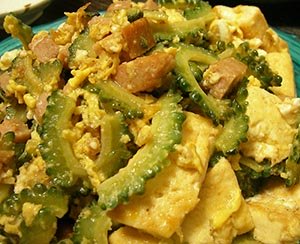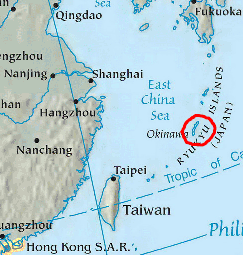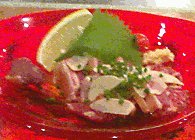Okinawa diet
Okinawa diet plan, off late, has taken the center stage of discussion among nutrition scientists, and health-conscious individuals alike.
What is so special about Okinawa islanders' diet?
One may wonder how East-Asians, especially Japanese live longer than their counterparts in other parts of the world. Indigenous Okinawa islanders, situated at the southern tip of Japan in the vast Pacific Ocean, have an interesting diet plan. People here, however, reportedly have the longest life expectancy than anywhere else on the planet!
 |
| Goya chanpuru. Bitter melon slices stir-fried with tofu, onion, and egg, in one of the Okinawa delicacies. Photo courtesy: jetalone |
According to the report by a research agency, a typical Okinawan may live an average of 100 years of healthy, and productive life. Many theories postulated that the secret of centenarians lies in their genetic constitutional makeup. However, recent community research studies on the Okinawa population suggest that the most important factor influencing their longevity is the simple food they consume, the knowledge handed over to them by their ancestors for centuries.
Okinawa island (Japan) on the world map
 |
| Okinawa island circled in red. |
Salient features of Okinawa diet:-

|
| Yagisashi-thin slices of goat meat with lemon. Photo courtesy: Yuki |
Calorie-restricted diet: The diet of the Okinawan people is 20% less in calories than an average Japanese consumes. Their food is consistently averaging no more than one calorie per gram, and the average Okinawan has a BMI (Body Mass Index) of 20. Many research studies firmly suggest the human body receives more harmful free radicals from food than they through external agents like bacteria, viruses, chemicals, etc.
Calorie restriction, therefore, is thought to improve health and slow the aging process in some animal models like rodents by limiting their dietary energy intake below the daily average needs.
Antioxidant-rich diet: The Okinawa diet is composed mainly of green/orange/yellow (GOY) vegetables, fruits, roots, and tubers. These foods are rich sources of antioxidant vitamins like vitamin-C, vitamin-A, and flavonoid polyphenolic compounds like ß-carotenes, lutein, xanthins, and minerals like calcium, iron, potassium, and zinc.
Low in fat and sugar: The Okinawa diet is low in fat, and has only 25% of the sugar and 75% of the cereals of the average dietary intake of a Japanese. Limiting fat and sugar in the diet can help prevent coronary heart disease and stroke risk.
Vegetarian and seafood rich: The islander's traditional diet includes a relatively small amount of fish and somewhat more in the form of soy, low-calorie vegetables like bitter melon, and other legumes. Almost no meat, eggs, or dairy products are consumed. Fish provides omega-3 essential fatty acids like alpha-linolenic acid (ALA), eicosapentaenoic acid (EPA), and docosahexaenoic acid (DHA). Besides being an excellent source of protein, soy (in the form of tofu), contains health-benefiting compounds like soluble dietary fiber, tannin antioxidants, and plant sterols. Altogether, these phytonutrients offer protection against heart diseases, stroke, colon, and prostate cancers.
The advocates of the Okinawa diet (The Okinawa Diet Plan, a book by Bradley Wilcox, MD, D. Craig Wilcox, Ph.D. and Makoto Suzuki, MD), divide food items into four categories based on their caloric density, as follows:
The "featherweight" foods: Food groups that provide less than or equal to 0.8 calories per gram belong to this category. Citrus fruits like orange, low-calorie vegetables like spinach, cucumber, etc. One can eat many servings per day without any reservations.
The "lightweight" foods: Food items with a calorific density of 0.8 to 1.5 per gram fall in this category. Certain fruits like banana and vegetables like potato are examples in this category. One should consume these in moderation.
The "middleweight" foods: Food groups having a caloric density from 1.5 to 3.0 calories per gram, such as cereals like wheat, legume products, and lean meat included under this category. It advised that one should eat only while carefully monitoring the portion size.
The "heavyweight" foods: Food items that provide 3 to 9 calories per gram (300 to 900 calories per 100 g) belong in this category. Many oils and fats, nuts, oil seeds, and red meat fall in this category, which one should eat only sparingly.
Okinawa diet is simple and close to nature. It is composed mainly of green/orange/yellow (GOY) vegetables, fruits, roots, and tubers and simple seafood. On average, each Okinawan consumes no more than one calorie per gram of food, and median BMI (Body Mass Index) is 20.
Here is a list of a few interesting books on the Okinawa diet plan available from Amazon stores.
 |
The Okinawa Program : How the World's Longest-Lived People Achieve Everlasting Health-And How You Can Too.
Author: Bradley J. Willcox

|
The Okinawa Diet Plan: Get Leaner, Live Longer, and Never Feel Hungry.
Author- Bradley J. Willcox.

|
50 Secrets of the World's Longest Living People.
Author: Sally Beare
≻≻-Back to Home page from Okinawa diet.